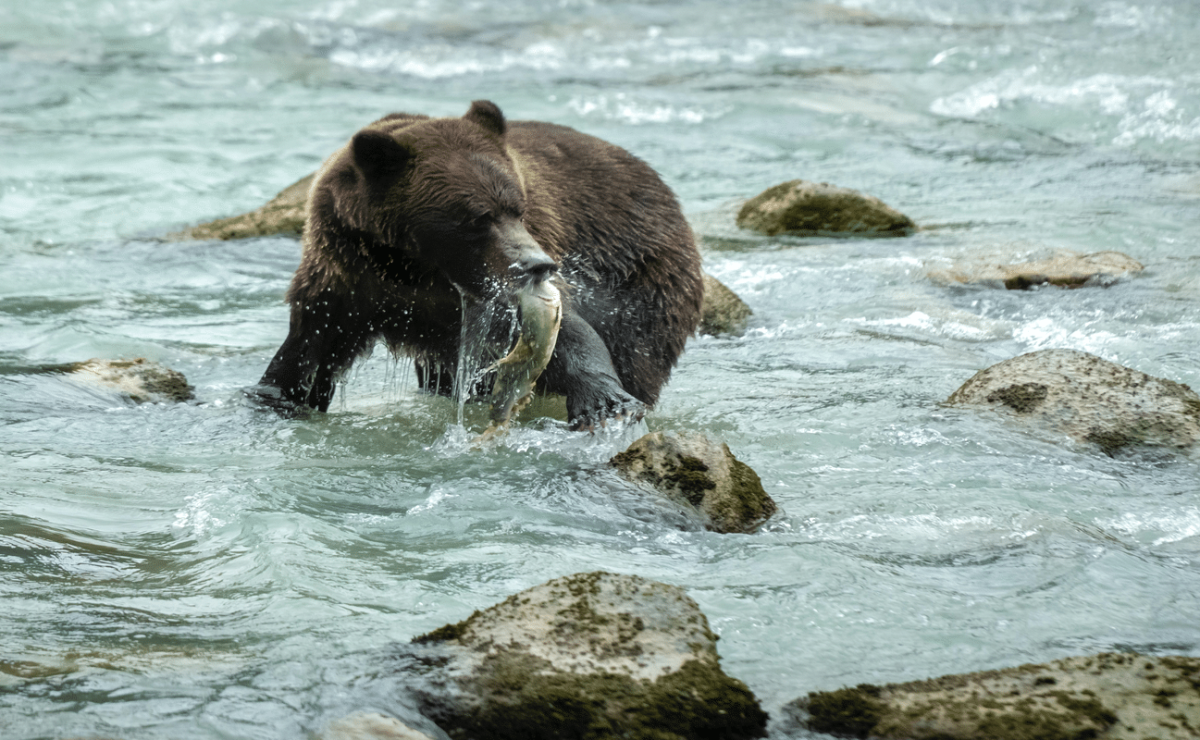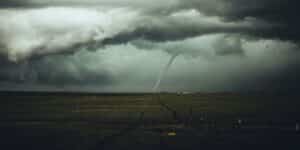“If it’s brown, lay down, if it’s black, fight back, if it’s white, goodnight.” Although fascinating, bears are dangerous and deadly animals. Grizzly bears are no exception…and if you live anywhere near them, you need to know how to survive their attacks!
Grizzly bears inhabit various regions of North America, from Alaska to Mexico. Some grizzly bears populate old forests, while others prefer rivers and coastlines. There are approximately 60,000 wild grizzly bears out there, with 50% of them living in Alaska.
On average, there are 44 reported grizzly bear attacks each year. Even though these bears are rather strong, less than 10% of their attacks end up being fatal. On the other hand, as human settlements are expanding, the number of bear attacks is slowly rising with each new year.
Many of these attacks occur because victims don’t understand grizzly behavior. In short, they were in the wrong place at the wrong time. If you live anywhere near grizzly bears, or you plan a trip to a place with grizzly bears, you should read this article. Here, we will help you understand grizzly behavior and teach you how to protect yourself against an attack…
The best way to stay safe is to keep your distance away from grizzlies. But what if you can’t avoid them, and right now, you encounter one? First of all, you can’t outrun a grizzly bear, so don’t even try to do it. If you start running, the bear will chase you and catch you in no time.
Instead, try to remain calm. Don’t scream or yell. Don’t show your teeth, and don’t make eye contact with the bear. Avoid making any sudden movements, and try to leave the area slowly.
In case that bear is approaching you, you should curl into a ball or lay flat with your stomach on the ground. Also, if you have a bear or pepper spray, this would be a good time to use it.
How to Recognize a Grizzly Bear
Grizzly bears are famous for their brown fur, making them easily differentiated from black or polar bears. However, there are also other physical features of grizzly bears that can help you recognize them:
- Shoulder hump that’s distinctive and higher than the rump
- Short and round ears
- Long and slightly curved front claws
- Grizzly bears are larger than black bears, 3-5 feet tall.
- The face profile at the muzzle looks a bit curved upwards
There are also some behavioral characteristics specific to grizzly bears, especially when compared to black bears:
- Grizzly bears are less tolerant of people than black bears
- When threatened, grizzly bears become aggressive
- Grizzlies aren’t great tree-climbers
Read Grizzly Bear’s Body Language
If you encounter a grizzly bear, knowing how to read their body language can make a difference between life and death. Sometimes, grizzly bears are simply curious, but their body language gets mistaken for aggression.
Aggressive grizzly bears will show these signs:
- Charging at your direction
- Stomping and swatting the ground
- Baring teeth
- Laying back the ears
- Raising fur on their back
Also, if the grizzly bear is growling, roaring, huffing, snorting, or clacking its teeth, these sounds are indicative of aggression. On the other side, a curious grizzly will do this:
- Tilt its head
- Stand on its hind legs
- Stay in a neutral and relaxed position
Still, keep in mind no matter how silent, peaceful, and relaxed the grizzly bear might look, they can still become aggressive in no time.
Prevention Strategies: Avoiding Bear Encounters
If you are spending time in bear country, you probably know that avoiding grizzly bears is the best safety method. First, this might seem counterintuitive, but you should make frequent and regular noises. The bears (and other animals) will know that you are near them and will try to avoid you.
Avoid being in the wild during dawn and dusk because that’s when grizzly bears are the most active. Stay vigilant and aware of your surroundings. Don’t wear headphones, and don’t look at your phone. Instead, listen to the sounds around you and watch out for possible bear tracks.
When setting a campsite, choose a place that gives you a good view of your surroundings. Avoid camping near rivers and streams because that’s where grizzly bears come to drink water and hunt for food.
Speaking of food, avoid bringing foods with strong scents with you. Store all of your food a bit further away from your tent. Don’t even bring your toothbrush and toothpaste inside the tent.
In the case that a grizzly bear notices these scents, it will come to investigate, and you don’t want it to investigate your tent while you are in it. For this same reason, keep your cooking area away from the tent.
How to Respond to a Grizzly Bear Approach
Carrying a bear or pepper spray can save your life, so be sure to always have it by your side. If possible, learn how to use it even before you go into the wild. In case you end up needing that spray, you won’t have much time to figure out how to use it.
You should also know when to use it. Wait until the bear is within 30 feet (10 meters) away from you. Spray slightly downward because that is where the bear’s head and eyes will be. Spray in short bursts. Don’t use all of the spray at once, in case you need to use it again.
Make sure that the spray doesn’t end up on you. Slowly back away as you spray the bear. Before you even start spraying, there are some things you can do to de-escalate the situation…
If the bear starts approaching you, stay calm, don’t try to run, and assess the bear’s demeanor. Does it look defensive, aggressive, or neutral? In either case, try to retreat slowly without any sudden movements.
Bear Spray Facts: Usage and Effectiveness
According to a 2009 study, bear spray is 90% effective, with 98% of people that used it ended up unharmed. In comparison, firearms are 84% effective, but the injury rate is the same as in the unarmed scenario.
Bear sprays are specifically designed to deter bears (and aggressive dogs), and some can even spray as far as 40 feet (13 meters). Make sure to choose EPA-approved bear sprays because they are effective yet humane to the bears.
For example, regular pepper sprays aren’t a good option, and you should only use them when you have nothing better. Pepper sprays have a much higher concentration of capsaicin, the substance responsible for the burning sensation. However, these sprays have a much shorter range, about 10 feet.
The best way to store and carry bear spray is on a holster attached to your belt, chest, or waistband. Don’t keep it in your backpack or other locations that will take more time to access the spray
During the Attack: Defensive Vs. Predatory Bears
In most cases, when a grizzly bear attacks you, it does it because it feels threatened. So, if you play dead and stay calm, they will eventually give up. Lay on your stomach, use your hands to cover your neck as much as possible, and spread your legs so that the bear can’t flip you over. This way, you will protect your internal organs and neck arteries.
However, if you notice that the bear is predatory, then pretending to be dead won’t be as effective. A defensive bear will huff and puff and even swat on the ground to warn you that it perceives you as a threat. It might even pretend to charge at you to force you to leave. In short, defensive bears will try to warn you before they attack!
Predatory grizzly bears, on the other side, will give you no warning. They will simply charge at you, and they won’t bluff. Their goal isn’t to scare you away but to hunt you down and maybe even eat you.
In that case, you will need to fight back. Bear spray can buy you some time to run away. However, if you don’t have it or it doesn’t work as intended, you will need to fight. Aim for the ears and muzzle. Throw stones or poke them with a stick. You’re fighting for your life, so give it all you’ve got!
Post-Encounter: Report and Seek Help
If you get alive after the attack, you need to seek help and report the attack. Wait until you are certain that the bear is gone because you don’t want it to attack you again as you start to leave the area.
Even if your injuries aren’t serious, you should seek medical help. The health professionals will stitch your wounds and give you antibiotics and various shots. You should also seek psychological support after the attack because the whole experience can be traumatic.
Don’t forget to report the encounter to the local park authorities. They can prevent similar things from happening to other people.
In conclusion, grizzly bear encounters and attacks can be terrifying experiences, but you can still make it out alive and even unharmed if you follow our tips. Enjoy nature and its beauty, but remember that it can be deadly as well!




